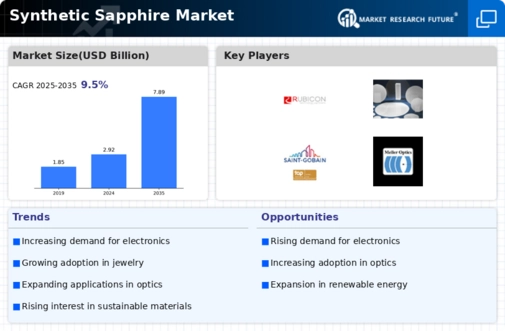Synthetic Sapphire Market Summary
The Global Synthetic Sapphire Market is projected to grow significantly from 2.92 USD Billion in 2024 to 7.90 USD Billion by 2035.
Key Market Trends & Highlights
Synthetic Sapphire Key Trends and Highlights
- The market is expected to experience a compound annual growth rate (CAGR) of 9.46% from 2025 to 2035.
- By 2035, the market valuation is anticipated to reach 7.89 USD Billion, reflecting robust growth potential.
- in 2024, the market is valued at 2.92 USD Billion, indicating a strong starting point for future expansion.
- Growing adoption of synthetic sapphire in various applications due to its superior durability is a major market driver.
Market Size & Forecast
| 2024 Market Size | 2.92 (USD Billion) |
| 2035 Market Size | 7.90 (USD Billion) |
| CAGR (2025-2035) | 9.45% |
Major Players
Kyocera Corporation, Rubicon Technology, Monocrystal, CeramOptec GmbH, Saint Gobain, Meller Optics, Crystal Growth Properties, OptoSigma Corporation, GT Advanced Technologies, Tamura Corporation, Roditi International, Namiki Precision Jewel, An Optics, Crystal Systems, Preciosa Crystals















